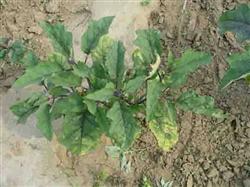Control methods of Sclerotinia sclerotiorum in Chrysanthemum

First, the symptoms of damage: waterlogged disease spots appeared in the middle and lower part of the stem at first, and then turned gray; under humid conditions, the disease part was soft rot, superficial white mildew layer, and in the later stage, the cortex of the diseased stem was moldy and fissured, and there were mouse dung-like black sclerotia in the endophy. sometimes sclerotia are also produced on the stem surface. 2. Morphological characteristics of pathogens: the pathogen is the sclerotia produced by Sclerotiniasclerotiorum (Lib.) deBary, which is oval, irregular, initially white, and then the outer becomes black, the size of 2~5Xl~3 (mm), on PDA, the flora is white, felted, the mycelium is spreading, rough, and grows rapidly. The hyphae are pentachromatic, branched, and produce conidiophores. Some small bottle peduncles are irregularly clustered at the top of the conidiophores or at the top of their branches, and the tiny conidia with dense pentachromatic unicellular cells are only 1.5 × 1 / 2 microns in size. A week later, a large black irregular sclerotia was gradually formed in the outer layer after initial white. Third, the characteristics of the disease: overwintering with sclerotia in the soil, on the diseased remains or mixed in compost. The sclerotia of overwintering sclerotia germinated under suitable conditions to produce ascomycetes. After the ascomycetes matured, the spores were emitted and spread with the wind to infect the surrounding plants in case of the change of air humidity. In addition, the sclerotia sometimes directly produces hyphae, the hyphae on the diseased plants have strong infectivity, the hyphae develop rapidly, and the pathogenic parts rot. Sclerotia are produced when nutrients are consumed to a certain extent, and sclerotia germinate without dormancy. The disease occurs under cool and humid conditions, and the optimum temperature is 5-20 ℃ and 15 ℃. Ascospores 0 Mel 35 ℃ could germinate, and 5 Mel 10 ℃ was the most favorable. The mycelium could grow at 0-30 ℃, and 20 ℃ was the most suitable. The temperature of sclerotia formation was consistent with the temperature required for mycelium growth, and 50 ℃ of sclerotia was killed in 5 minutes. Bacteria have strict requirements for humidity. In moist soil, sclerotia only survive for 1 year; long-term stagnant water in soil will die within 1 month. It can survive for more than 3 years in dry soil, but it is not easy to germinate. Sclerotia germination requires high humidity and cool conditions. The development of ascomycetes after germination requires sufficient water for 10 consecutive days, relative humidity 70%, ascospores can survive for 21 days; relative humidity 100% only survived for 5 days. It occurred in Guangdong from October to December, and the damage was serious. 4. prevention and control methods: at the initial stage of the disease, 40% polysulfide suspension 600-700 times or 70% thiophanate methyl wettable powder 500-600 times, 50% mixed thiophanate 600 times, 80% carbendazim 600-700 times, 35% sclerotia light suspension 600-800 times, once every 7-10 days, 2-3 times in a row.
- Prev

Control methods of Fusarium wilt of chrysanthemum
First, the symptoms of damage: at the beginning of the disease, the leaf color became light yellow, wilted and drooping, the base of the stem also became light brown, the vascular bundles of the stem base became brown, and the vascular bundles of the upward expanding branches gradually became light brown, which led to root bark necrosis or blackening and rot, and some stems split at the base. It occurs when the humidity is high.
- Next

Control methods of Verticillium wilt of chrysanthemum
First, damage symptoms: the occurrence of Verticillium wilt in chrysanthemum is common, the leaves of infected plants are yellow and weak, yellowing is limited to a few lower leaves at first, then increases gradually, and the old leaves turn brown and die. Flowers are small or cannot blossom. 2. Morphological characteristics of pathogens: the pathogen is VerticilliumdahliaeKleb. It belongs to half-known fungi. The mycelium.
Related
- Fuxing push coffee new agricultural production and marketing class: lack of small-scale processing plants
- Jujube rice field leisure farm deep ploughing Yilan for five years to create a space for organic food and play
- Nongyu Farm-A trial of organic papaya for brave women with advanced technology
- Four points for attention in the prevention and control of diseases and insect pests of edible fungi
- How to add nutrient solution to Edible Fungi
- Is there any good way to control edible fungus mites?
- Open Inoculation Technology of Edible Fungi
- Is there any clever way to use fertilizer for edible fungus in winter?
- What agents are used to kill the pathogens of edible fungi in the mushroom shed?
- Rapid drying of Edible Fungi

